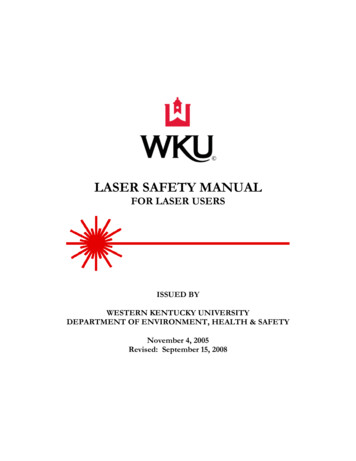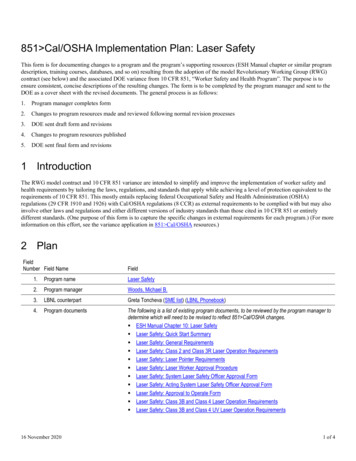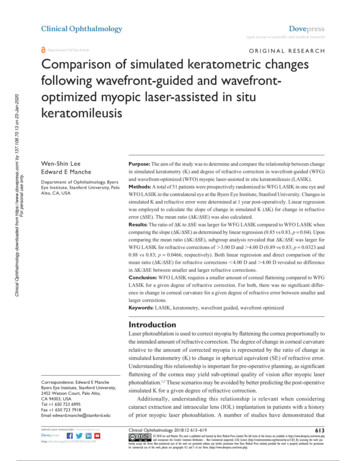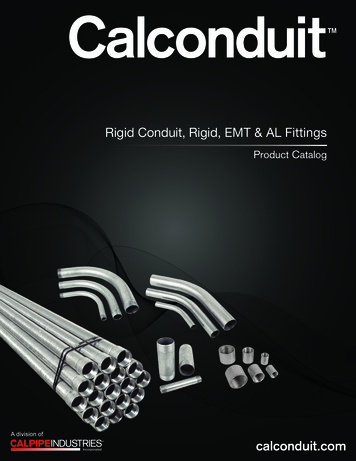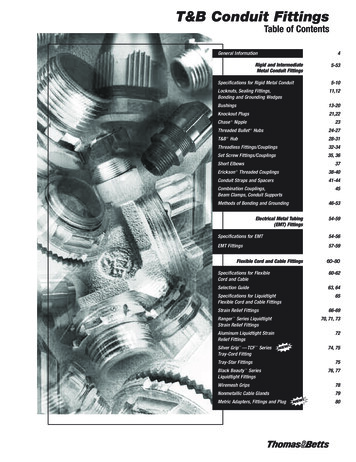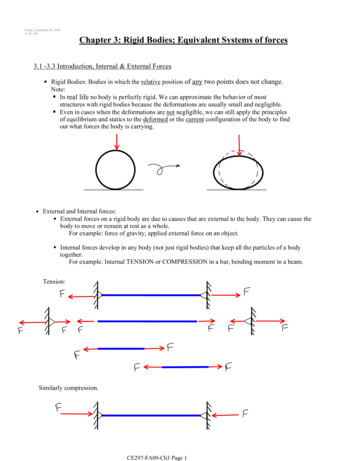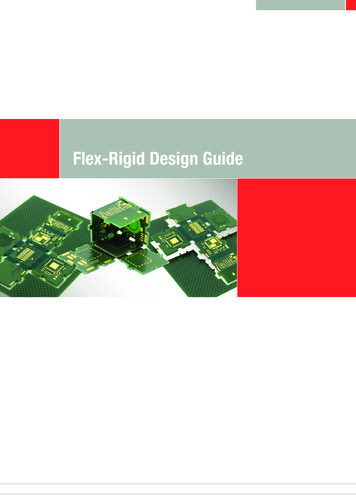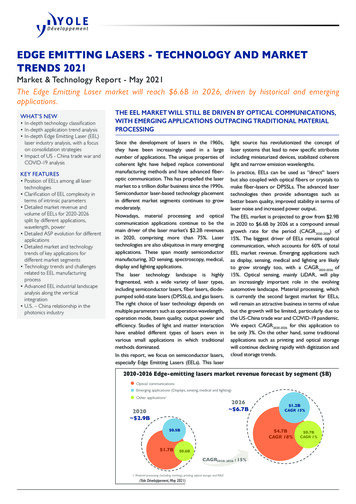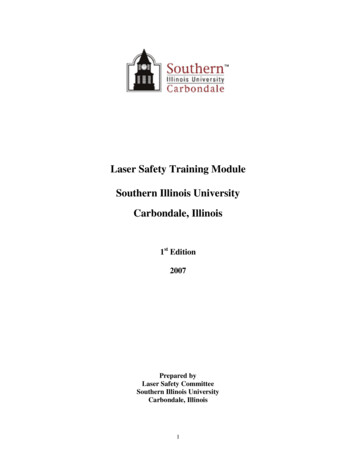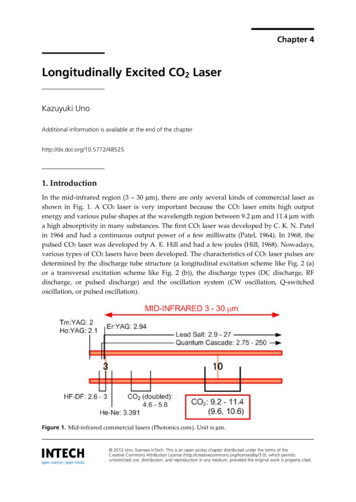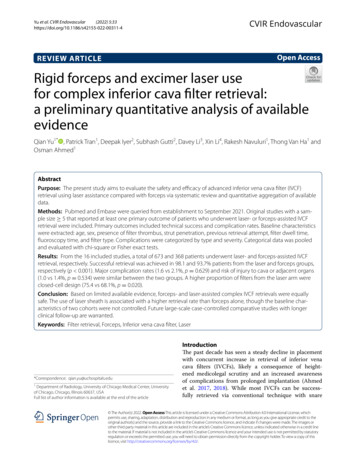
Transcription
(2022) 5:33Yu et al. CVIR 11-4CVIR EndovascularOpen AccessREVIEW ARTICLERigid forceps and excimer laser usefor complex inferior cava filter retrieval:a preliminary quantitative analysis of availableevidenceQian Yu1* , Patrick Tran1, Deepak Iyer2, Subhash Gutti2, Davey Li3, Xin Li4, Rakesh Navuluri1, Thong Van Ha1 andOsman Ahmed1AbstractPurpose: The present study aims to evaluate the safety and efficacy of advanced inferior vena cava filter (IVCF)retrieval using laser assistance compared with forceps via systematic review and quantitative aggregation of availabledata.Methods: Pubmed and Embase were queried from establishment to September 2021. Original studies with a sample size 5 that reported at least one primary outcome of patients who underwent laser- or forceps-assisted IVCFretrieval were included. Primary outcomes included technical success and complication rates. Baseline characteristicswere extracted: age, sex, presence of filter thrombus, strut penetration, previous retrieval attempt, filter dwell time,fluoroscopy time, and filter type. Complications were categorized by type and severity. Categorical data was pooledand evaluated with chi-square or Fisher exact tests.Results: From the 16 included studies, a total of 673 and 368 patients underwent laser- and forceps-assisted IVCFretrieval, respectively. Successful retrieval was achieved in 98.1 and 93.7% patients from the laser and forceps groups,respectively (p 0.001). Major complication rates (1.6 vs 2.1%, p 0.629) and risk of injury to cava or adjacent organs(1.0 vs 1.4%, p 0.534) were similar between the two groups. A higher proportion of filters from the laser arm wereclosed-cell design (75.4 vs 68.1%, p 0.020).Conclusion: Based on limited available evidence, forceps- and laser-assisted complex IVCF retrievals were equallysafe. The use of laser sheath is associated with a higher retrieval rate than forceps alone, though the baseline characteristics of two cohorts were not controlled. Future large-scale case-controlled comparative studies with longerclinical follow-up are warranted.Keywords: Filter retrieval, Forceps, Inferior vena cava filter, Laser*Correspondence: qian.yu@uchospitals.edu1Department of Radiology, University of Chicago Medical Center, Universityof Chicago, Chicago, Illinois 60637, USAFull list of author information is available at the end of the articleIntroductionThe past decade has seen a steady decline in placementwith concurrent increase in retrieval of inferior venacava filters (IVCFs), likely a consequence of heightened medicolegal scrutiny and an increased awarenessof complications from prolonged implantation (Ahmedet al. 2017, 2018). While most IVCFs can be successfully retrieved via conventional technique with snare The Author(s) 2022. Open Access This article is licensed under a Creative Commons Attribution 4.0 International License, whichpermits use, sharing, adaptation, distribution and reproduction in any medium or format, as long as you give appropriate credit to theoriginal author(s) and the source, provide a link to the Creative Commons licence, and indicate if changes were made. The images orother third party material in this article are included in the article’s Creative Commons licence, unless indicated otherwise in a credit lineto the material. If material is not included in the article’s Creative Commons licence and your intended use is not permitted by statutoryregulation or exceeds the permitted use, you will need to obtain permission directly from the copyright holder. To view a copy of thislicence, visit http:// creat iveco mmons. org/ licen ses/ by/4. 0/.
Yu et al. CVIR Endovascular(2022) 5:33and sheath, filters that are embedded in the caval wall,tilted, and/or of a permanent design are often recalcitrant to standard techniques and may result in retrievalfailure. These chronic indwelling filters may also lead tocaval thrombosis, perforation, adjacent organ injury, andpatient anxiety. Advanced, non-standard approaches toIVCF removal include a variety of techniques, includingwire loop methods, balloon dissection, rigid forceps, and/or excimer laser ablation (Merritt et al. 2022). Amongthese complex IVCF retrieval techniques, rigid forcepsand excimer laser provide operators the ability to dissect an endothelialized filter from the caval wall throughblunt dissection and thermal ablation, respectively. However, both techniques demand operator proficiency dueto risk of damaging the surrounding structures. To date,only a few institutions represented in the published literature are equipped with both and have reported outcomes. Knowledge of IVCF retrieval and complicationrates associated with their use is also limited by scarceevidence and potentially subject to experience bias whenevaluated on a single institution basis. As a result, analysis of aggregate data from existing knowledge on forcepsand laser techniques may shed further light on procedural safety and effectiveness. The purpose of the presentstudy was to therefore characterize the safety and efficacyof these two dissection approaches via systematic reviewand quantitative analysis.MethodInstitutional Review Board Approval was not requiredfor this review, as no human or animal subject wasinvolved, and it complies with the Preferred ReportingItems for Systematic Reviews and Meta-analysis Statement (PRISMA) (Moher et al. 2010).Literature screeningA PICO-based (population/patient, intervention, comparison, outcome) search strategy was conducted usingPubmed and Embase from establishment to September 2021. The following keyword terms were or“laser”or“excimer”or“endobronchial”) and “inferior vena cava” and “filter”.The following inclusion criteria were adopted: a) studies including patients with IVCF retrieved with excimerlaser or endobronchial forceps; b) studies with at leastone clinical outcome reported including technical success or complication rates; c) studies with sample sizes ofat least 5 patients. A study was excluded if the followingcriteria were met: a) non-human studies; b) case reportsor studies with sample size 5 patients (forceps or lasersubgroup); c) absence of original data (letter, editorial,commentary, and review); d) studies that did not specifythe outcomes of the forceps- or laser-assisted subgroupPage 2 of 7separately from the rest; e) epidemiological studies; f )preclinical studies. Endnote 20 (Clarivate Analytics,Philadelphia, Pennsylvania) was used to identify andremove duplicates. Articles were initially screened basedon titles, abstracts, and keywords, followed by a comprehensive review of full text of the remaining studies. Adetailed screening process is depicted in Fig. 1.Data acquisition and statistical analysisThe primary outcomes were technical success and complication rates, which were pooled. Reasons for failurewere reviewed. Complication rates were categorizedbased on type, and severity was divided as major andminor based on Society of Interventional RadiologyGuidelines (Sacks 2003). Major complications are definedas complications 1) requiring therapy or minor hospitalization, 2) requiring major therapy, unplanned increasein level of care, or prolonged hospitalization, 3) permanent adverse sequelae, 4) and death. Minor complicationsare defined as complications 1) requiring no therapy orresulting in no consequence and 2) requiring nominaltherapy but without consequence or overnight observation only. Baseline characteristics were retrieved, including author, publication year, region, sample size, filtertype, filter dwelling type, procedure information (fluoroscopy time and radiation exposure), and follow-up length.Data was retrieved by three authors (QY, DI, and SG);any discordance was resolved by discussion. All quantitative analyses were performed with Stata 15.1 (STATACorp., College Station, TX, USA). The pooled results ofthe forceps and laser subgroups were compared with chisquare or Fisher exact tests for categorical variables.ResultsBaseline characteristicsAmong the initial 463 search results, a total of 16 studies met criteria for the present analysis (Fig. 1), comprising of 673 and 368 patients who underwent laser- andforceps-assisted IVCF retrieval, respectively (Ahmedet al. 2020; Al-Hakim et al. 2014; Anzai et al. 2021; Averyet al. 2015; Bundy et al. 2021; Chen et al. 2019; Desai et al.2020; Dowell et al. 2016; Joe et al. 2019; Kuo et al. 2020;Stavropoulos et al. 2015; Tavri et al. 2019; von Stempelet al. 2019; Lian et al. 2019; Scher et al. 2015; Poshamet al. 2017) (Table 1). Outcomes of laser-assisted retrievalwere reported in three studies; forceps-assisted retrievalwere reported in twelve studies; only one study reportedoutcomes of both modalities (Ahmed et al. 2020). Basedon available data for the laser and forceps groups, theaverage age was 49 and 46 years with a female proportion of 55.0 and 55.2%, respectively. A higher proportionof IVCF retrieved with laser-assistance presented witha thrombosed filter prior to retrieval (11.8 vs 4.0%). The
Yu et al. CVIR Endovascular(2022) 5:33Page 3 of 7Fig. 1 Flow diagram of literature screeningpercentage of IVCFs with caval penetration into adjacentorgans was 36.8% in the forceps arm. By contrast, onlyone study from laser-assisted group elaborated on theproportion of IVCFs with cava wall penetration, reporting that 16.2% patients presented with pain from strutsdamaging adjacent organ; among those patients fromthe laser cohort with reported data, there were penetrations involving small bowel (n 21), pancreas (n 3),liver (n 1), psoas muscle (n 6), vertebral body (n 10), and aorta (n 8) (Kuo et al. 2020). The proportionof caval penetration in the forceps cohort with pain wasnot reported. The proportion of patients in who failedprevious attempts at IVCF retrieval was 85.7% in theforceps cohort and 88.9% in the laser cohort. Patientswho underwent laser-assisted retrieval had a longeraverage IVCF dwelling time (52.3 vs 18.5 month) and ahigher proportion of closed-cell design (75.4 vs 68.1%).The average intraoperative fluoroscopy time was similarbetween two groups (23.3 vs 28.2 min).Technical successThe pooled success rate for IVCF retrieval was 98.1%among patients who underwent laser-assisted retrieval,which was higher than the forceps cohort (93.7%, p 0.001, Table 1). According to Kuo et al., three patientswith 2 Optease (Cordis Endovascular, NJ, USA) and 1Trapease (Cordis Endovascular, CA, USA) filters, respectively, presented with bulky calcified thrombi within thefilter that could not be safely removed using thrombectomy and were subsequently too large for the laser sheathto engage. In the forceps group, Avery et al. reportedtwo cases in which IVCFs were not able to be retrieved
Yu et al. CVIR Endovascular(2022) 5:33Page 4 of 7Table 1 Pooled baseline characteristics and clinical outcomes of included studyLaserForcepsP-valueSample Size673368NAAge49 (500)47.3 (250)NA%Female55.0% (275/500)55.2% (138/250)0.9586Filter Thrombus11.8% (59/500)4.0% (6/150)0.001Strut Penetration into Adjacent Organ16.2% (81/500)a36.8% (68/185) 0.001Previous Retrieval Attempt88.9% (594/668)85.7% (240/280)0.166Dwell Time (month)52.3 (143)18.5 (225)NAFluoroscopy (min)23.3 (143)28.2 (201)NA% Closed-cell Design75.4% (456/605)68.1% (175/257)0.020Successful Retrieval98.1% (636/648)93.7% (342/365)0.002Major Iatrogenic Injury to Cava or Adjacent Organ1.0% (7/673)1.4% (5/318)0.534Major Complication1.6% (11/673)2.1% (7/338)0.629Parentheses indicate included patient sample size of selected parameterNA Not applicableaSymptomatic cases from strut penetration into adjacent organs onlydue to caval wall penetration and attachment to adjacentorgans; in four cases, initial retrieval was unsuccessfuland an additional attempt was carried out on a separateday (S.Table 1).ComplicationThe pooled major complication was low per category(S.Table 2). No procedure related mortality was reported.There were four cases of caval injury during laser-sheathIVCF retrieval, requiring balloon tamponade and/orstent-graft placement, while such complications occurredin five patients who underwent forceps-assisted retrieval.Adjacent organ injury occurred in three cases of the lasergroup due to the removal of struts penetrating into adjacent arteries: One patient developed renal infarction afterremoving a Celect filter (Cook Medical, Bloomington,IN)with its tip penetrating the renal artery; one case ofarterial bleeding occurred after removing a Greenfieldfilter (Boston Scientific, Watertown, MA) with leg adjacent to a branch of the sacral artery; another case of IVChemorrhage and gastroduodenal artery (GDA) bleeding involving a penetrating, tilted, and fractured Optionfilter (Argon Medical, Plano, TX) adjacent to the GDAoccurred as a sequela of asymmetric advancement of thelaser sheath in an attempt to free the filter, but resulted inexcessive damage to the cava wall. Other major complications include one case of iatrogenic strut embolizationinto the atrium (forceps), iatrogenic thromboembolismdue to thrombus detaching from the filter (2 lasers, 1forceps), deep vein thrombosis in lower extremities (forceps), sepsis from removing a filter with strut penetratinginto the bowel (laser), major access hematoma requiringovernight observation (laser), and a filter that was stuckat the access site requiring surgical retrieval (forceps).No statistically significant difference was seen betweenlaser and forceps in terms of the rate of major injury tothe vena cava or adjacent organs (1.0 vs 1.4%, p 0.534,Table 1). The pooled major complication rates were alsosimilar (1.6 vs 2.1%, p 0.629). Other complications thatwere minor or not further elaborated upon by originalauthors included minor renal vein hematoma, postoperative chest pain, postoperative hypoxia, and minor cavalpseudoaneurysm.DiscussionAccording to the present quantitative analysis of published literature, the use of laser and forceps assistancein complex IVCF retrieval was highly successful at ratesof 98.1 and 93.7%, respectively. Meanwhile, their pooledmajor complication rates were less than 2%, highlightingthe safety of both maneuvers at centers with expertise.While both are highly effective, the use of these two techniques are contingent on the condition of the indwellingIVCF and its anatomical complexity. For instance, forcepsare versatile. They can be useful for separating the apex offilters from the caval wall, capture tilted apices, removefractured fragments, and release filter parts incorporatedinto the caval wall. In comparison, lasers can dissect thetissue adhering to the filter struts when the apex can beengaged. In practice, these two devices are often complementary, and the application of one device does notpreclude the other. In scenarios in which both techniquesmay be feasible, operator preference/comfort and availability is a primary determinant for which technique isutilized.
Yu et al. CVIR Endovascular(2022) 5:33Compared to conventional technique with snareand sheath, forceps offers operators greater versatility in filter manipulation. For filters with tilted apices, forceps can be useful in disengaging the apex ofa filter away from the caval wall, allowing direct filterretrieval or creating a window for conventional technique with snare and sheath. In cases where struts areembedded, forceps can provide more traction than traditional snares. For thrombosed and endothelializedfilters, forceps allow the operator to dissect adhesionsbetween filter and caval wall. In addition, forceps canbe useful for retrieval of fractured or embolized filterfragments (Stavropoulos et al. 2015). From an economical perspective, forceps can be re-used multiple timesbefore physically wearing out. Thus, the higher numberof published studies describing forceps-assisted IVCFretrieval can be attributed to its versatility, low-cost,and high availability.By contrast, in cases when filter struts are embeddedbut the apex is able to be engaged, laser can reduce thepulling force required to dissect the endothelialized tissue attached to the struts and facilitate filter retrieval.The average filter dwelling time was longer amongpatients who required laser-assisted retrieval (52.3vs 18.5 months), which allowed more extensive filterendothelialization to occur and therefore necessitatedlaser for dissection. Furthermore, a higher percentageof filters retrieved with laser appeared to be of closedcell design (75.4 vs. 68.1%, p 0.02). The filter designs,such as TrapEase (Cordis Endovascular, CA, USA) andOptEase (Cordis Endovascular, NJ, USA) filters are typically more difficult to extract as they are associated withincreased surface area contact with the cava in comparison to their open-cell counterparts, resulting in extensive endothelization and fibrosis of the IVC (Desai et al.2020; Rimon et al. 2011; Oliva et al. 2005; Chick et al.2016; Kuo et al. 2012). Excimer laser offers the option ofdissecting this fibrotic tissue with high precision. Dueto the nature of study designs, included cohort studieson laser-assisted IVCF retrieval included both technically difficult closed-cell IVCFs and straightforwardcases where the filter was well-positioned without strutpenetration. It is unclear if the heterogenous mixture of“easy” and “difficult” filters create an overall cohort similar to the forceps cohort. Further, an unreported percentage of patients who underwent laser-assisted IVCFretrieval were also managed with forceps, as these twomodalities are not mutually exclusive in practice. Assuch, despite the statistical significance of higher technical success rate of laser-assisted IVCF retrieval (p 0.001), potential variation in patient’s baseline characteristics and selection bias undermine the clinical value ofcomparative analysis in the present study. Nonetheless,Page 5 of 7the findings of this study tout the safety and efficacy ofboth of these techniques when employed in the properclinical scenario.While the paucity of data on laser-assisted IVCFretrieval often raises concern regarding its safety profile owing to the use of invasive thermal ablation, thepooled data of 673 patients from the present study suggests that laser sheath did not confer a higher risk tosurrounding organs compared to forceps. The pooledrate of major injury to the cava and adjacent organswere 1.0% (7/673) among patients who underwentlaser-assisted IVCF retrieval, with similar rates in theforceps-assisted group (1.4%, 5/318). Furthermore,previous literature also suggests that most iatrogeniccaval pseudoaneurysms during complex filter retrievalwith forceps and laser resolve upon balloon tamponadewithout the need for covered stent placement, suggesting a low clinical significance (Hadied et al. 2021). Inthe present study, no difference was observed regarding pooled major complication rates between the twogroups (2.1 vs 1.6%, p 0.629). These findings suggestthat laser-sheath photoablation can be safely implemented in complex IVCF retrieval.The first detailed report on forceps-assisted IVCFretrieval in human dates to 2006, when Stavropoulos et al. described its use for a Recovery filter (BardPeripheral Vascular, Tempe, AZ) with the tip embedded in the IVC (Stavropoulos et al. 2006). By contrast,the debut of laser sheath technique did not occur untillater in 2010, when Kuo et al. successfully retrieved aGünther-Tulip (Cook Medical, Bloomington, IN) filter by circumferentially ablating the dense fibrotic tissue between the struts and caval endothelium (Kuoand Cupp 2010). Compared to relatively more available evidence on the use of forceps, the majority ofpeer-reviewed articles on laser-assisted IVCF retrievalare limited to case reports; only four institutions havepublished data with a sample size at least five patients(Ahmed et al. 2020; Desai et al. 2020; Kuo et al. 2020;von Stempel et al. 2019). In addition to its relativelylate introduction to clinical practice, its higher cost andoff-label use status also hindered the laser-sheath technique from gaining wider acceptance. Moreover, laserrequires safety training and certification along with a250-volt physical outlet connection, while forceps areless costly and can be re-sterilized for repeated use.Cost-effective analyses are necessary to evaluate theunderstand the added cost of laser or forceps for complex filter retrieval. Interestingly, despite the relativeabundance of cohort studies on forceps-assisted IVCFretrieval, the pooled sample size of the laser-sheatharm is one-fold higher (673 vs 368). As the laser-baseddevice recently obtained breakthrough designation and
Yu et al. CVIR Endovascular(2022) 5:33received FDA authorization for removal of IVCFs, anincrease of evidence from additional institutions can beexpected to be published in the near future.The present study has several limitations. First, thereare variations of patient baseline characteristics. Fewstudies reported the type of filter, positioning of thefilter, previous retrieval attempts, or degree of strutpenetration into the cava, which determine the choiceof laser, forceps, or potentially a combination of both.Similarly, a lack of standardization exists with respectto which technique should be used after standard filterremoval failure. Compared to laser, the use of forceps ismore versatile, which degrades the value of this studyserving as a head-to-head comparison as the clinicalproblem and applications are different. Second, thenumber of included studies and the total sample sizewere limited. Only four studies were available in thelaser sheath arm, whereas the total number of patientsfrom the forceps group is small. Due to this heterogeneity, implementing chi-square or Fisher exact tests tocompare simple pooled outcomes may not be accurate.Third, most studies are of relatively low quality giventheir retrospective and single-arm design. Several studies were excluded from the present analysis becauseoutcomes of the laser and forceps subgroups were notspecified separately (Kuo et al. 2012; Zhou et al. 2012;Kleedehn et al. 2019). While publishing these separatesubgroup outcomes will increase the sample size formeta-analysis, high-quality case-controlled comparative studies are also warranted to evaluate laser- andforceps-assisted complex IVCF retrieval in selectedscenarios. Finally, most of the included studies weretechnically oriented, only reporting the immediate clinical results. These studies rarely investigated if complications occurred, or if symptomatic relief was achievedin the post-operative period. Long-term follow-up datais necessary to shed light on the durability of clinicalbenefits provided by each advanced IVCF retrievaltechnique.ConclusionBased on the limited available evidence, both forcepsand excimer laser were equally safe and effective strategies for complex IVC filter retrieval. The use of lasersheath is associated with a higher retrieval rate thanforceps alone, though the present quantitative analysis is limited by heterogeneity. Future case-controlled,comparative studies with large sample sizes and clinicalfollow-up are warranted.AbbreviationsIVCF: Inferior vena cava filter; GDA: Gastroduodenal artery.Page 6 of 7Supplementary InformationThe online version contains supplementary material available at https:// doi. org/ 10. 1186/ s42155- 022- 00311-4.Additional file 1: Supplement Table 1. Baseline Characteristic and Success Retrieval Rates of Included Studies. Supplement Table 2. Complication Rates and Iatrogenic Filter Fracture.AcknowledgementsNone.Financial disclosureOsman Ahmed reported receiving personal fees from Argon Medical,Penumbra, Medtronic, Johnson & Johnson, and Boston Scientific and grantsfrom Canon Medical, outside the submitted work. No other disclosures werereported.Authors’ contributionsQY: Manuscript writing, data analysis, corresponding author. PT: Manuscriptwriting, data collection. DI: Data collection, review and edit manuscript. SG:Data collection review and edit manuscript. DL: Data collection, review manuscript. XL: manuscript writing, review. RN: Manuscript writing, review. TVH:Manuscript writing, data analysis. OA: manuscript writing, edit, data analysis.All authors have read and approved the submitted manuscript. The manuscript has not been submitted elsewhere nor published elsewhere in whole orin part. The material was not presented at an SIR Annual Scientific Meeting.Authors’ informationNone.FundingNone.Availability of data and materialsThe datasets generated and/or analyzed during the current study are frompublished manuscripts.DeclarationsEthics approval and consent to participateWaived by IRB because the present study is a systematic review and metaanalysis. No patient/animal data was included.Consent for publicationNot applicable.Competing interestsThe authors declare that they have no competing interests.Author details1Department of Radiology, University of Chicago Medical Center, Universityof Chicago, Chicago, Illinois 60637, USA. 2 School of Medicine, George Washington University, Washington D.C. 20052, USA. 3 College of Medicine, University of Illinois at Chicago, Chicago, IL 60612, USA. 4 Department of Radiology,University of Pennsylvania, Philadelphia, Pennsylvania 19104, USA.Received: 29 April 2022 Accepted: 27 June 2022ReferencesAhmed O, Patel K, Patel MV et al (2017) Declining national annual IVC filterutilization: an analysis on the impact of societal and governmental communications. Chest 151(6):1402–1404Ahmed O, Wadhwa V, Patel K, Patel MV, Turba UC, Arslan B (2018) Risingretrieval rates of inferior vena cava filters in the United States: insights
Yu et al. CVIR Endovascular(2022) 5:33from the 2012 to 2016 summary Medicare claims data. J Am Coll Radiol15(11):1553–1557Ahmed O, Kim YJ, Patel MV et al (2020) A single-institutional comparativeanalysis of advanced versus standard snare removal of inferior vena cavafilters. J Vasc Interv Radiol 31(1):53-60.e1. https:// doi. org/ 10. 1016/j. jvir. 2019. 07. 014 (In eng)Al-Hakim R, Kee ST, Olinger K, Lee EW, Moriarty JM, McWilliams JP (2014) Inferior vena cava filter retrieval: effectiveness and complications of routineand advanced techniques. J Vasc Interv Radiol 25(6):933–9; quiz 940.https:// doi. org/ 10. 1016/j. jvir. 2014. 01. 019 (In eng)Anzai H, Takaesu S, Yaguchi T et al (2021) Impact of advanced technique onimprovement in the retrievable inferior vena cava filter retrieval rate. CircJ 85(4):377–384. https:// doi. org/ 10. 1253/ circj. CJ- 20- 0772 (In eng)Avery A, Stephens M, Redmond K, Harper J (2015) Initial experience usingthe rigid forceps technique to remove wall-embedded IVC filters. J MedImaging Radiat Oncol 59(3):306–11. https:// doi. org/ 10. 1111/ 1754- 9485. 12299 (In eng)Bundy JJ, Chick JFB, Srinivasa RN et al (2021) Retrieval of Bard Simon Nitinolinferior vena cava filters: approaches, technical successes, complications,and clinical outcomes. Phlebology 36(7):555–561. https:// doi. org/ 10. 1177/ 02683 55520 925986 (In eng)Chen S, Gao Y, Wang W et al (2019) Long-term clinical outcomes of complicated retrievable inferior vena cava filter for deep venous thrombosispatients: safety and effectiveness. Med Sci Monit 25:128–134. https:// doi. org/ 10. 12659/ MSM. 911813 (In English)Chick JFB, Stavropoulos SW, Shin BJ et al (2016) A 16-F sheath with endobronchial forceps improves reported retrieval success of long-dwelling “closedcell” inferior vena cava filter designs. J Vasc Interv Radiol 27(7):1027–1033Desai KR, Xiao N, Salem R, Karp JK, Ryu RK, Lewandowski RJ (2020) Excimerlaser sheath-assisted retrieval of “closed-cell” design inferior vena cavafilters. J Am Heart Assoc 9(17):e017240. https:// doi. org/ 10. 1161/ jaha. 120. 017240 (In eng)Dowell JD, Wagner D, Elliott E, Yildiz VO, Pan X (2016) Factors associated withadvanced inferior vena cava filter removals: a single-center retrospective study of 203 patients over 7 years. Cardiovasc Intervent Radiol39(2):218–26. https:// doi. org/ 10. 1007/ s00270- 015- 1256-3 (In eng)Hadied MO, Hieromnimon M, Kapke J et al (2021) Caval pseudoaneurysms following complex inferior vena cava filter removal: clinical significance andpatient outcomes. Vascular 29(4):624–629Joe WB, Larson ML, Madassery S et al (2019) Bowel penetration by inferior venacava filters: feasibility and safety of percutaneous retrieval. AJR Am J Roentgenol 213(5):1152–1156. https:// doi. org/ 10. 2214/ ajr. 19. 21279 (In eng)Kleedehn M, Moore K, Longo K, Woo K, Laeseke P (2019) An analysis of factorsassociated with increased fluoroscopy time or the need for complextechniques at IVC filter retrieval. Eur Radiol 29(4):1931–1938Kuo WT, Cupp JS (2010) The excimer laser sheath technique for embeddedinferior vena cava filter removal. J Vasc Interv Radiol 21(12):1896–1899Kuo WT, Cupp JS, Louie JD et al (2012) Complex retrieval of embedded IVCfilters: alternative techniques and histologic tissue analysis. CardiovascIntervent Radiol 35(3):588–597Kuo WT, Doshi AA, Ponting JM, Rosenberg JK, Liang T, Hofmann LV (2020) Laserassisted removal of embedded vena cava filters: a first-in-human escalationtrial in 500 patients refractory to high-force retrieval. J Am Heart Assoc9(24):e017916. https:// doi. org/ 10. 1161/ jaha. 119. 017916 (In eng)Lian W, Tian F, Li S, Gu X, Jia Z (2019) Forceps-assisted removal of difficult-toretrieve filters: preliminary results. Ann Vasc Surg 61:371–376Merritt T, Powell C, Hansmann J (2022) Safety and effectiveness of advancedretrieval techniques for inferior vena cava filters compared to standardretrieval techniques: a systematic review of the literature and metaanalysis. J Vasc Interv Radiol 33(5):564-571.e4Moher D, Liberati A, Tetzlaff J, Altman DG, Group P (2010) Preferred reportingitems for systematic reviews and meta-analyses: the PRISMA statement.Int J Surg (London, England) 8(5):336–341Oliva VL, Szatmari F, Giroux M-F, Flemming BK, Cohen SA,
"or"endobronchial") and "inferior vena cava" and "lter". e following inclusion criteria were adopted: a) stud-ies including patients with IVCF retrieved with excimer laser or endobronchial forceps; b) studies with at least one clinical outcome reported including technical suc-cess or complication rates; c) studies with sample sizes of
